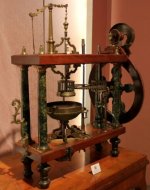Asquith
Diamond
- Joined
- Mar 3, 2005
- Location
- Somerset, UK





Lens grinding machine, second half of 18th century, credited to Andrea Frati.
On display in the excellent Museo Galileo (Institute and Museum of the History of Science) in Florence, Italy.
Not the happiest marriage of architecture and mechanical engineering, but the early use of a gear cluster is interesting.
Some parts are missing.

